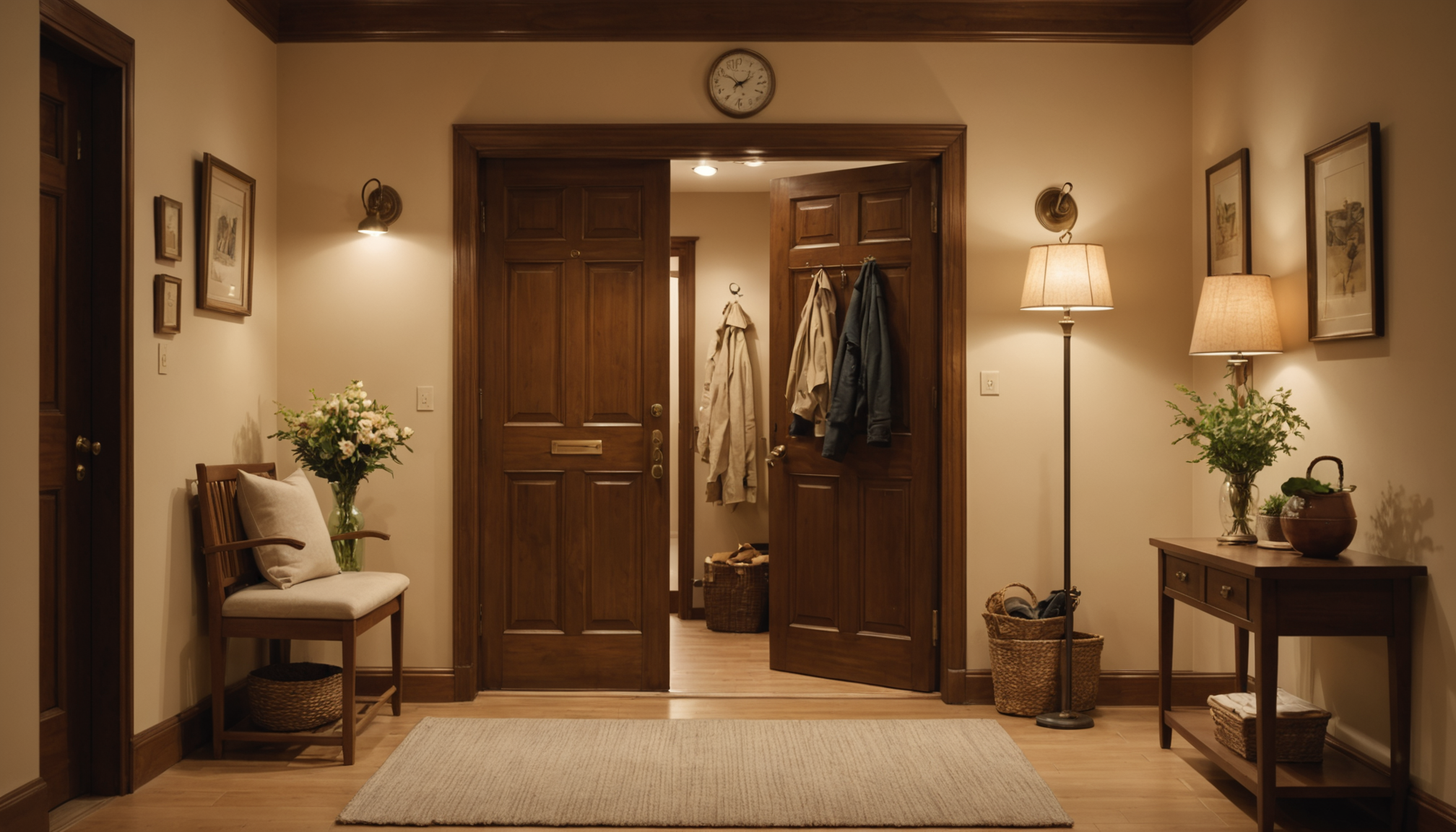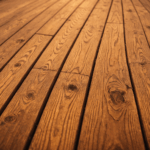Before making any significant changes or improvements, it’s crucial to take a step back and evaluate your current entryway. Assessing this space with a critical eye will guide your decisions on how to effectively transform it into a welcoming and functional area. By understanding the existing layout, design challenges, and opportunities for improvement, you can focus your efforts on where they will matter most.
Begin by examining the condition of your entryway. Consider the durability of materials and overall structural integrity. Look for signs of wear and tear, such as cracked tiles or peeling paint, that indicate areas in need of immediate attention. Check the door’s functionality, not just in terms of aesthetics, but also its alignment, hinges, and locks, ensuring they are both secure and efficient for enhanced safety. Remember that your entryway is the first impression of your home, setting the tone for what lies beyond. Therefore, it should be as inviting as it is secure.
Additionally, take note of how the space is used. Is it serving its purpose effectively, or is there room for improvement? Evaluate the flow of traffic and how easily people can move through this area. Are there any obstacles that hinder movement or elements that could be repositioned to facilitate better accessibility?
Consider the lighting situation as well. An often-overlooked aspect of an entryway, proper lighting can dramatically enhance both functionality and ambiance. Whether you’re entering the house at dusk or leaving before dawn, assessing whether your entryway is adequately lit is crucial for both aesthetics and safety. Think about incorporating multiple lighting solutions to cover all times of the day and needs.
Another factor to evaluate is the stylistic coherence of your entryway. Does it complement the rest of your home’s aesthetic, or does it feel like an afterthought? This space should act as a seamless transition into your home, setting the stage for your personal style. The color scheme, textures, and materials used should resonate with the interior design themes present in adjacent spaces.
Lastly, consider the storage needs served by your entryway. For many households, this area functions as more than just a passage; it’s also a critical storage space for items like coats, shoes, and keys. Ensure there is ample room for these essentials without cluttering the space.
| Aspect | Consideration |
| Structural Integrity | Check for wear and tear, door alignment, and functionality. |
| Lighting | Evaluate current lighting and consider enhancements for safety and ambiance. |
| Functionality | Assess traffic flow and accessibility. Optimize space use. |
| Stylistic Coherence | Ensure entryway design complements the rest of the home. |
| Storage | Identify and address storage needs for efficiency and organization. |
By conducting a thorough assessment of your current entryway, focusing on these areas, you lay the foundation for a successful transformation. Whether you’re considering a DIY approach or hiring pros, knowing exactly what your entryway requires will streamline the process, ensuring that each replacement or enhancement is both purposeful and effective.
updating the door
Updating the entry door can significantly transform the appearance and functionality of your entryway, while also enhancing security and energy efficiency. Follow these steps to ensure a refreshed and effective update for your door:
1. Choose the Style and Material
Start by selecting a door style that aligns with the aesthetic of your home. Consider materials such as wood, fiberglass, or steel:
– Wood doors offer natural beauty and warmth but require regular maintenance to prevent weather damage.
– Fiberglass doors are durable, energy-efficient, and can mimic the appearance of wood without the maintenance.
– Steel doors provide robust security and are cost-effective, though they may dent over time.
2. Consider Energy Efficiency
An energy-efficient door can reduce utility costs and enhance comfort:
– Look for doors with adequate insulation, such as ones with foam cores.
– Check for weatherstripping quality to prevent drafts.
– Consider doors with double or triple-pane glass inserts if they include windows, which help maintain temperature control.
3. Focus on Security Features
Safety should be a top priority when selecting a new door:
– Install a deadbolt lock in addition to your standard lock for improved security.
– Ensure the doorframe is solid and that hinges are tamper-resistant.
– Consider smart lock technology for improved accessibility and security.
4. Plan for the Installation
Whether you take a DIY approach or choose to hire professionals, proper installation is crucial:
– If installing yourself, measure the door frame accurately to ensure a snug fit and avoid air leaks.
– Hiring pros may be beneficial for complex installations or if structural adjustments are needed to replace or expand the existing entryway.
5. Choose Accessories and Finishes
The right accessories can enhance both the function and appeal of your door:
– Consider handlesets that offer both style and comfort.
– Add a knocker or a kick plate for a touch of elegance.
– Choose finishes that complement the exterior paint or stain colors for a cohesive look.
6. Deal with Permitting and Regulations
Before proceeding, check local building codes to ensure compliance:
– Determine if a permit is required for replacing the door, particularly if altering the structure.
– Ensure that your choice respects neighborhood guidelines if applicable, especially in historic districts.
7. Test Everything Thoroughly
Once installed, ensure the door operates smoothly and effectively:
– Open and close the door several times to check for any sticking or misalignment.
– Test locks and any additional security features to confirm they are working correctly.
– Inspect the seal around the door to avoid drafts or leaks, and make adjustments if needed.
By carefully planning and executing the door update, you enhance not just the look and feel of your entryway but also boost your home’s safety and efficiency.
incorporating lighting solutions
Lighting solutions are a crucial component in reshaping your entryway to be both inviting and functional. The proper illumination can transform your space, making it not only more visually appealing but also improving its overall utility. Thoughtfully selected lighting solutions create an atmosphere that welcomes guests and enhances safety, particularly in darker hours.
Begin by identifying the primary needs of your entryway lighting. Natural light, when available, should be maximized to maintain a warm and inviting ambience. If your entryway lacks sufficient natural light, consider layering multiple sources to create a balanced effect. This means combining ambient, task, and accent lighting to cater to various needs and times of day.
Ambient lighting serves as your main light source, providing general illumination. Fixtures such as ceiling or pendant lights work well to ensure broad coverage. Select a fixture that complements your home’s style; a modern chandelier or a rustic lantern can serve as both a light source and a decor statement.
For task lighting, focus on areas that require more concentrated light. This might include a table lamp on a console table or wall-mounted fixtures that flank the doorway, assisting in activities like finding keys or checking your appearance before leaving the house.
Accent lighting can be employed to highlight architectural features or artwork within your entryway—think of spotlights or LED strips that create focal points and add depth to your space. These are particularly effective at night when they can draw attention to specific design elements or create a charming glow.
Another consideration is energy efficiency. Choose LED bulbs for their long lifespan and lower energy consumption. Not only are they environmentally friendly, but they can also help to reduce your utility bills—an important factor when deliberating over any entryway remodel.
It’s also wise to incorporate lighting controls such as dimmers or smart lighting systems. These allow for adjustable brightness levels, accommodating different moods and times of day with ease, all while boosting the flexibility of your lighting setup.
Finally, if your entryway includes exterior elements like a porch or front steps, ensure these are well-lit to enhance safety and create a welcoming approach to your home. Motion sensor lights or well-placed sconces can provide essential illumination while adding a layer of security.
Each lighting solution caters to a different functional or aesthetic need, but together they work to create an entryway that’s as practical as it is enticing—enhancing both your home’s safety and its appeal. By mindfully selecting and layering lighting, you ensure your entryway replaces the mundane with an area that sets the tone for the rest of your home.
choosing the right flooring
When considering how to replace your entryway flooring, it’s essential to focus on both durability and style, ensuring the new surface not only complements your décor but also withstands daily use. Start by evaluating the specific needs of your household: Do you have pets that might scratch the surface? Is the entryway a high-traffic area that requires extra durability? These factors will guide your choice of material.
Opt for materials that are hard-wearing and easy to maintain. Tiles, for instance, are an excellent choice due to their longevity and resistance to wear. Ceramic or porcelain tiles offer numerous design possibilities, from classic mosaics to contemporary large-format options. They also provide a surface that’s straightforward to clean, making them ideal for managing dirt and moisture brought in from outside.
For a warmer aesthetic, consider engineered wood or luxury vinyl planks. Engineered wood provides a similar look to traditional hardwood but with increased resistance to moisture, while luxury vinyl offers the charm of wood or stone without the maintenance hassles. Both materials come in various finishes and colors, allowing you to tailor the entryway to match your interior style seamlessly.
Natural stone is a premium choice that brings an element of luxury and timelessness to any entryway. Options like slate, marble, or travertine are visually stunning yet durable underfoot. While their initial cost might be higher and they require sealing to maintain their pristine condition, the investment can significantly enhance your home’s value and aesthetic appeal.
When replacing entryway flooring, also think about safety features. Slippery floors can pose a hazard, especially in areas exposed to moisture. Opt for surfaces with a textured finish or add non-slip treatments to smooth surfaces to enhance safety. Area rugs or hallway runners can also soften the space, prevent slips, and serve as an added design element, but ensure they are secured to prevent tripping.
If you’re considering hiring pros for installation, this decision ensures precise fitting and avoids potential pitfalls that might arise from a DIY approach, particularly with complex tile patterns or stone installations. Professional installation guarantees that your new flooring adheres to the necessary standards, lasting the test of time while providing the safety and style you seek.
By choosing the right flooring, you not only create a beautiful transition from outdoors to indoors but also usher in long-lasting style, safety, and functionality, firmly setting the tone as you extend a warm welcome to every visitor.
adding decor and accessories
When it comes to replacing or enhancing the decor and accessories of your entryway, think of it as an opportunity to merge practicality with personal expression. The right decorative elements can transform a simple entryway into a true reflection of your home’s character and warmth. Start by selecting a welcoming color palette that sets the tone immediately upon entry. Consider hues that complement your home’s overall color scheme while also making the space feel open and inviting.
Introduce functional items such as coat racks or hooks, which provide a designated place for outerwear, promoting both organization and convenience. This small addition can dramatically improve the functionality of your entryway, especially if space is limited. For those with more room, a freestanding coat stand or an elegant console table with drawers offers additional storage while serving as a stylish focal point.
Mirrors are another strategic decor choice. Not only do they enhance the perception of space, making your entryway appear larger, but they also add a touch of elegance. Choose a mirror with a unique frame that ties into the overall design theme. Wall art and photos can further personalize the space, allowing you to showcase favorite memories or art pieces.
Additionally, a well-chosen rug can add texture and warmth. Opt for durable materials that can withstand the high-traffic nature of an entryway, and ensure it has non-slip backing for safety. The right rug can also tie together various design elements, creating a cohesive look.
Think about adding decorative lighting fixtures such as a chic table lamp or a distinctive hanging pendant. These not only provide necessary illumination but can also serve as artistic elements in their own right. Choose fixtures that resonate with the aesthetic of your home, whether it’s a vintage-inspired fixture or a sleek modern design.
Consider bringing in elements of nature with potted plants or floral arrangements. These add a fresh, lively appeal and connect your indoor space with the outdoors. Low-maintenance plants can be a practical choice for those with busy schedules, offering visual interest with minimal upkeep.
Lastly, do not underestimate the impact of small details, such as decorative trays, baskets, or bowls for keys and mail. These accessories keep your entryway tidy while maintaining a sense of style.
By thoughtfully choosing decor and accessories, your entryway becomes a functional area that is both practical and visually appealing. This space not only welcomes visitors with open arms but also provides a cohesive introduction to the warmth and style of your entire home.
In conclusion, revamping your entryway is more than just a makeover of one space; it’s an opportunity to enhance the overall experience of entering your home. By assessing and updating key elements like the door, lighting, flooring, and decor, you create a welcoming ambiance that reflects your style while incorporating practical improvements. Whether you choose to undertake these changes as a DIY project or with the expertise of hiring pros, the results will offer a satisfying blend of beauty and functionality, ensuring your entryway is as inviting as it is efficient.


